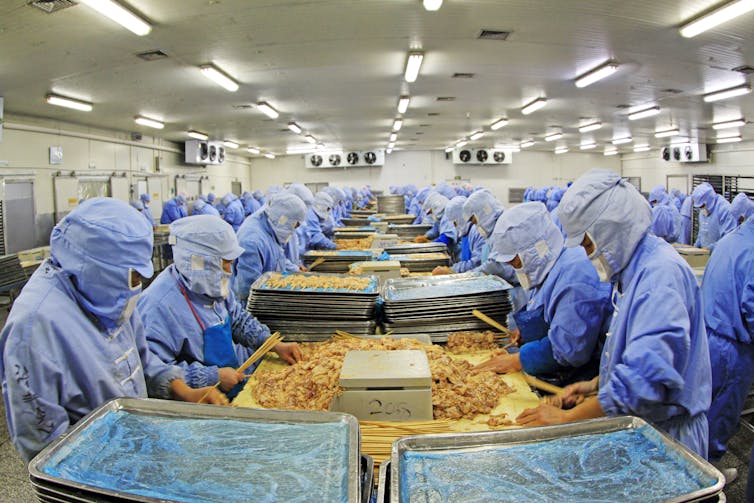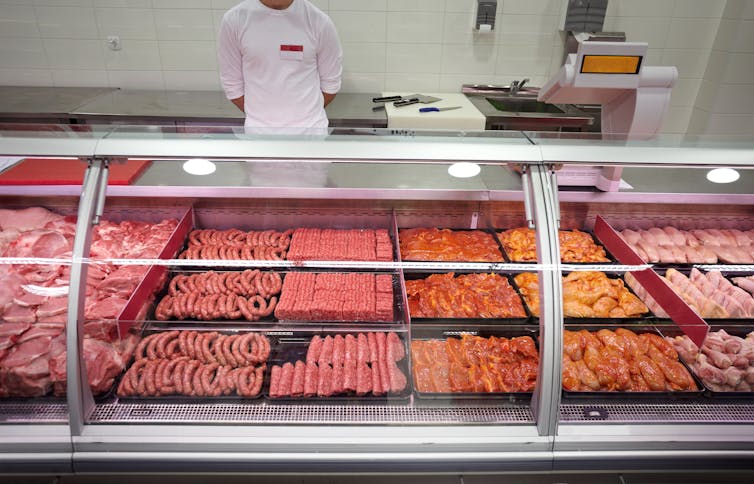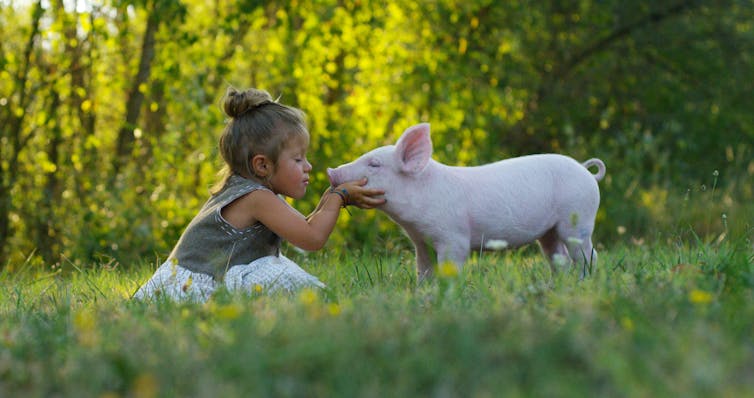How Has Human Environmental Factors Hurt Animals
When we hear virtually the horrors of industrial livestock farming – the pollution, the waste matter, the miserable lives of billions of animals – information technology is hard not to feel a twinge of guilt and conclude that we should eat less meat.
Nonetheless about of us probably won't. Instead, we will mumble something about meat existence tasty, that "anybody" eats it, and that we only purchase "grass fed" beef.
Over the next year, more than fifty billion land animals will be raised and slaughtered for food effectually the earth. About of them volition be reared in conditions that cause them to suffer unnecessarily while also harming people and the environment in significant ways.
This raises serious ethical problems. Nosotros've compiled a list of arguments against eating meat to help you decide for yourself what to put on your plate.
1. The environmental impact is huge
Livestock farming has a vast environmental footprint. It contributes to land and water deposition, biodiversity loss, acid rain, coral reef degeneration and deforestation.
Nowhere is this bear upon more than apparent than climatic change – livestock farming contributes eighteen% of human produced greenhouse gas emissions worldwide. This is more than than all emissions from ships, planes, trucks, cars and all other transport put together.
Climatic change alone poses multiple risks to wellness and well-existence through increased run a risk of farthermost weather events – such as floods, droughts and heatwaves – and has been described as the greatest threat to human wellness in the 21st century.
Reducing consumption of fauna products is essential if nosotros are to meet global greenhouse gas emissions reduction targets – which are necessary to mitigate the worst effects of climate change.
2. It requires masses of grain, h2o and state
Meat production is highly inefficient – this is specially true when it comes to carmine meat. To produce one kilogram of beef requires 25 kilograms of grain – to feed the animal – and roughly 15,000 litres of water. Pork is a piddling less intensive and chicken less still.
The calibration of the problem tin also be seen in land apply: around thirty% of the earth's land surface is currently used for livestock farming. Since nutrient, water and land are scarce in many parts of the world, this represents an inefficient apply of resources.

3. It hurts the global poor
Feeding grain to livestock increases global need and drives up grain prices, making it harder for the world's poor to feed themselves. Grain could instead be used to feed people, and water used to irrigate crops.
If all grain were fed to humans instead of animals, we could feed an actress 3.5 billion people. In brusque, industrial livestock farming is non only inefficient simply likewise not equitable.

4. It causes unnecessary fauna suffering
If we have, every bit many people do, that animals are sentient creatures whose needs and interests thing, then nosotros should ensure these needs and interests are at least minimally met and that nosotros do non cause them to suffer unnecessarily.
Industrial livestock farming falls well brusque of this minimal standard. Most meat, dairy and eggs are produced in ways that largely or completely ignore animal welfare – declining to provide sufficient space to move around, contact with other animals, and access to the outdoors.
In short, industrial farming causes animals to suffer without good justification.
5. Information technology is making us sick
At the production level, industrial livestock farming relies heavily on antibiotic use to accelerate weight gain and control infection – in the US, 80% of all antibiotics are consumed by the livestock industry.
This contributes to the growing public health trouble of antibiotic resistance. Already, more 23,000 people are estimated to die every year in the United states alone from resistant bacteria. Every bit this figure continues to rise, it becomes hard to overstate the threat of this emerging crisis.

High meat consumption – specially of red and processed meat – typical of most rich industrialised countries is linked with poor health outcomes, including heart disease, stroke, diabetes and diverse cancers.
These diseases stand for a major portion of the global disease burden so reducing consumption could offer substantial public health benefits.
Currently, the average meat intake for someone living in a high-income country is 200-250g a day, far higher than the 80-90g recommended by the United Nations. Switching to a more than found-based diet could save upwardly to 8m lives a year worldwide by 2050 and lead to healthcare related savings and avoided climatic change amercement of up to $1.5 trillion.
Ultimately, it'south unethical
Most people agree that equally a basic dominion an action that promotes the overall happiness of others is morally good, while an action that causes harm or suffering without good justification is morally incorrect.
Meat eating is wrong non considering there is something special most pigs or chickens or dogs or cats, just considering of the harm information technology causes, whether that damage is caused to animals, humans, or the wider environment.

Well-nigh people living in industrialised countries have historically unprecedented dietary option. And if our nutritional needs can now exist met by consuming foods that are less harmful, and then nosotros ought to cull these over foods that are known to cause more than harm.
Eating less meat and animal products is i of the easiest things we can do to live more ethically.
Source: https://theconversation.com/five-ways-the-meat-on-your-plate-is-killing-the-planet-76128
Posted by: mercerciat1967.blogspot.com

0 Response to "How Has Human Environmental Factors Hurt Animals"
Post a Comment